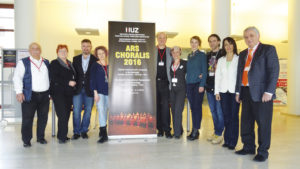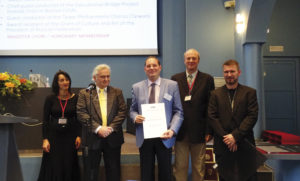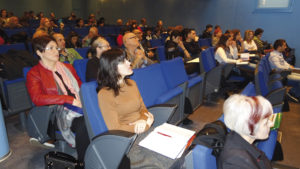"Ars Choralis", 4ème Symposium international de chant choral de Zagreb (31/03/16 – 02/04/16): de "l’art" choral à la "science" chorale?
Par Henri Pompidor, chef de chœur et enseignant
Dans nos sociétés contemporaines, aux quatre coins du globe, le chant choral fait l’objet d’un développement considérable et inédit. Multiforme, il se pratique dans les conservatoires de musique, les écoles, les universités, les lieux de culte, dans le cadre d’activités culturelles gérées par des associations confessionnelles ou non. Il joue un rôle social et éducatif indéniable pour transmettre des valeurs, créer et renforcer les liens dans des sociétés qui connaissent parfois une fragilisation du lien social. De prime abord, le chant choral se conçoit comme une pratique vocale fondée sur l’expérience, c’est-à-dire sur la tradition, ainsi que sur les connaissances et le charisme du chef de chœur : figure centrale, pivot de la transmission, il a pour rôle d’accompagner les chanteurs dans leur travail vocal et de leur transmettre un savoir acquis tout au long de ses années de direction.
Au-delà de leur nature éminemment singulière, il est intéressant de s’interroger sur la dimension inductive des pratiques chorales. Le chant choral devrait-il être réduit à une pratique musicale isolée des connaissances scientifiques? Ne serait-il pas pertinent de puiser dans un corpus de savoirs plus objectifs? Dans la plupart des cas, le savoir représenté par ce qui est désigné aujourd’hui sous l’appellation d’”art choral” est issu du travail empirique du chef de chœur. Sa pratique, y compris dans ses aspects les plus singuliers — qu’il s’agisse de la gestique, de l’interprétation, de la gestion proprement dite du chœur — est analysée et conceptualisée à partir d’une dimension subjective (le “ressenti” du chef de chœur). La diversité des situations et leurs spécificités culturelles enrichissent l’expérience du chef de chœur dans la conduite musicale et humaine du groupe choral. Cependant, ces approches fondées sur un savoir expérimental pourraient bénéficier considérablement de l’apport des sciences et des méthodes expérimentales, et être validées par elles. L’enjeu n’est pas tant d’opposer “l’art” choral à la nouvelle “science” chorale, où le premier serait le fruit des traditions, de l’histoire et de pratiques expérientielles, tandis que la seconde se nourrirait des apports de disciplines scientifiques comme la physique, l’acoustique, la physiologie, la médecine, la sociologie, la psychologie, etc., ou même de passer de l’un à l’autre; il conviendrait d’ailleurs de s’interroger sur les enjeux, en termes de légitimité et de crédibilité notamment, de ce glissement de l’art à la science. Il s’agit plutôt de revendiquer la nature résolument complexe, transversale et transdisciplinaire du chant choral comme objet ou champ de recherche. Car tout l’enjeu, justement, est d’articuler la complexité, afin de rassembler et de transmettre ces savoirs en tant que corpus sous des formes saisissables, appréhendables à tous les niveaux, celui des choristes comme celui des chefs de chœur.
De fait, le travail du chef de chœur ne peut se réduire aux connaissances fondées sur sa seule expérience. Il lui faut élargir ses apports et puiser dans d’autres disciplines pour mieux appréhender les dimensions musicales et humaines de son travail. Avec, à la clé, tout le bénéfice d’une approche scientifique des pratiques chorales, qui conférerait à l’art choral une dimension plus rationnelle. L’apport des sciences exactes et des sciences humaines à la musique a été fondamentale au cours du XXe siècle. Le fait musical – comme le fait vocal – peut s’analyser par une démarche scientifique dans tous ses aspects, notamment historiques et linguistiques. Élément constitutif de la musique, le chant choral est en passe de franchir cette étape méthodologique, pour proposer aux praticiens une véritable démarche de rationalisation des connaissances. C’est l’ensemble de ces connaissances rationnelles qu’il convient de comparer, de compléter et de diffuser, afin d’aboutir à la constitution de la “chorusologie” (chorusology), nouvelle discipline définie par Branko Starc dès l’ouverture du 1er Symposium de chant choral de Zagreb en 2010, champ transdisciplinaire situé à la croisée des travaux de la recherche scientifique sur les dimensions naturelles et culturelles de la voix collective. La “chorusologie” propose au monde choral une relation plus étroite entre les pratiques du chœur et les sciences.
Mais l’art choral a-t-il vraiment besoin de connaissances scientifiques pour se développer? Sans doute, si l’on considère tous les domaines que la direction de chœur présuppose (acoustique, physiologie, médecine, histoire de la musique, musicologie, et de nombreuses autres sciences humaines). Lors du dernier symposium de chant choral “Ars Choralis” organisé par la Fédération croate de chant choral à Zagreb du 31 mars au 2 avril derniers, chefs de chœur, professeurs d’université, médecins, physiciens, acousticiens, directeur d’école ont, par leurs interventions, apporté un éclairage plus objectif des pratiques chorales contemporaines, enrichissant un corpus de connaissances qui dépasse “l’art choral” et ouvre la voie à une analyse scientifique des pratiques chorales.
Ce quatrième symposium s’est ouvert sur des contributions relayant les derniers apports de la physiologie et de l’anatomie, notamment sur les caractéristiques de la voix et les conditions de son émission (Overtone singing, Anna-Maria Hefele, Allemagne), la respiration et la position du larynx (Flow-Ball, a new tool for practicing semi-occluded vocal tract gesture, Filipa La, Portugal), ainsi que les problèmes liés à son vieillissement (Aging of the vocal tract, Irena Hocevar, Slovénie), ou encore les interactions anatomiques de soutien vocal (A review of singing voice sub-system interactions, Christian Herb, Autriche). De nouveaux éclairages ont été apportés sur les conditions acoustiques de la voix chorale (Tuning considerations in capella choir singing, David Howard, Royaume-Uni), ainsi que sur l’émission vocale et la relation de bien-être qu’elle induit (Singing, brain and emotion – how do they connect, Per-Ake Lindestad).
Les dimensions physiologiques, anatomiques et acoustiques du chant choral n’ont pas occulté une autre dimension fondamentale, celle des sciences sociales et humaines. Nombreux furent les intervenants à rappeler les dimensions historiques et ethniques de la voix collective, avec, dans ce cadre, une lecture sociologique des pratiques chorales présentant la voix collective comme véhicule des valeurs et des normes propres à une société ou à un groupe (Choral singing and sociology: Sociology’s contribution to Art choral, Henri Pompidor, France). Le chant choral participe d’autant plus de ce champ social qu’il doit également être compris dans un contexte historique et analytique (Influence of the Gregorian chant in Duruflé’s music, Andrea Angelini, Italie).
Cette double dimension sociale et historique s’est également retrouvée dans la présentation d’institutions d’éducation chorale existantes, notamment en Tchéquie (Boys choir of the Czech Republic, Jaroslav Slais, Tchéquie), en Afrique du Sud (Boys choir : do they still matter?, Johannes Van der Sandt, Afrique du Sud) ou encore en Inde (Music education in India, Anjana Abraham, Inde). Ces écoles trouvent leur raison d’être dans l’apport bénéfique du chant choral pour l’éducation musicale (Cooperation between the music school and the environment, Martina Prevejsek, Croatie), le développement de la coopération chorale et la création de réseaux (The European network for Professional Chamber Choir, Babette Greine, Pays-Bas).
D’autres conférences ont eu pour objet l’analyse ethnologique et musicologique des pratiques vocales, avec notamment la présentation des répertoires nationaux de Croatie, le pays hôte (Techniques of the Croatian traditional singing, Bojan Pogrmilovic, Croatie), mais également de Malte (Music practice in Malta, Johen Galea, Malte), de Hongrie (The style of Gyorgy Orban, Katalin Kiss, Hongrie) ou encore de Russie (Russian contemporary choral performing and repertoire, Alexander Soloyev, Russie).
Les participants ont pu découvrir des pratiques vocales spécifiques, comme celles des “clics” caractéristiques de la musique vocale sud-africaine (Click sounds in South African Languages, Anne-Marie Van Der Walt, Afrique du Sud). Des ateliers leur ont permis de participer à l’élaboration et à l’exécution de pièces de Gospel (Lift every Voice, Reginald Golden, États-Unis), de chants traditionnels sud-américains (Let’s sing music of Mexico and Latin America, Marco Antonio Ugalde, Mexique) et même d’extraits de comédies musicales américaines (How to sing American musicals? David McShane, États-Unis).
En résumé, le quatrième symposium de Zagreb a su montrer l’importance de la recherche scientifique dans le développement des pratiques chorales. Les disciplines scientifiques, qu’elles proviennent des sciences exactes ou des sciences humaines, ont pu dialoguer et apporter un éclairage inédit sur le chant choral (The Learning conductor, Thomas Caplin, Norvège). Ces approches, qui ne remettent nullement en cause le caractère expérimental de l’art choral et la pratique singulière des milliers de chefs de chœur de par le monde, visent à proposer un corpus objectif et complémentaire de connaissances sur lequel les chœurs peuvent s’appuyer pour progresser. C’est le vœu exprimé par Branko Starc et les participants, qui invitent d’ores et déjà tous les autres acteurs du chant choral mondial à se retrouver à Zagreb en 2018 à l’occasion du 5ème Symposium international (Ars Choralis 2018).
Membre de la Société française des chefs de chœur, Henri Pompidor enseigne aujourd’hui le chant choral et la direction de chœur au Conservatoire de Paris Charles Munch (11ème arrondissement). Il est également le directeur musical du chœur du Conservatoire. Il consacre aussi son activité à l’enseignement du chant choral au niveau international, au travers de nombreuses concerts et master classes dans de nombreux pays du monde (Chine, Corée du Sud, Espagne, Indonésie, Japon, Malaysia, Taiwan, Vietnam…). Comme membre de jury, il est régulièrement invité à prendre part à des festivals et des compétitions internationales en Europe et à l’étranger (FIMC, A.C.J, Interkultur…). Courriel: henripompidor@hotmail.com


